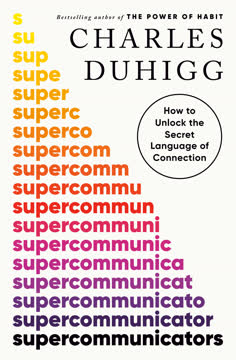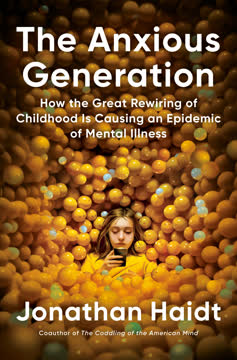Key Takeaways
1. The U-Shaped Happiness Curve: Life satisfaction dips in midlife and rebounds later
"We show that wellbeing reaches its minimum around the middle of life."
The happiness curve is a U-shaped pattern of life satisfaction that has been observed across cultures and even in great apes. This curve typically shows:
- High life satisfaction in young adulthood
- A gradual decline through the 30s and 40s
- A low point (bottom of the U) around age 50
- An upswing in satisfaction through the 50s and beyond
Research by economists like Andrew Oswald and David Blanchflower has consistently found this pattern in large-scale data sets from various countries. The curve persists even after controlling for factors like income, health, and marital status, suggesting that age itself influences life satisfaction independently of life circumstances.
2. Midlife malaise is normal, not a crisis, and affects even successful individuals
"Midlife slump (not "crisis"!) is completely normal and natural. Like teething or adolescence, it is a healthy if sometimes painful transition, and it serves a purpose by equipping you for a new stage of life."
Midlife dissatisfaction is often misunderstood as a "crisis," but it's typically a gradual, subtle shift in mood and outlook. Key characteristics include:
- Feeling stuck or unfulfilled despite outward success
- Questioning life choices and purpose
- Increased self-criticism and comparison to others
This malaise can affect highly successful individuals, as exemplified by the author's interviews with accomplished professionals who felt inexplicably dissatisfied. The important takeaway is that these feelings are a normal part of adult development, not a personal failing or sign of mental illness.
3. Expectations vs. reality: The root of midlife discontent
"My actual feeling of disappointment shrinks as I shed my unrealistic optimism."
The expectations gap is a key driver of midlife dissatisfaction. Research by economist Hannes Schwandt reveals:
- Young adults consistently overestimate their future life satisfaction
- This optimism bias gradually diminishes with age
- By midlife, reality often falls short of long-held expectations
This mismatch creates a feedback loop of disappointment:
- Past expectations weren't met
- Present reality feels unsatisfying
- Future outlook becomes pessimistic
Understanding this pattern can help individuals normalize their experiences and avoid self-blame for feelings of discontent.
4. Social comparison and hedonic adaptation contribute to midlife dissatisfaction
"One secret of happiness is to ignore comparisons with people who are more successful than you are: always compare downwards, not upwards."
Two psychological phenomena intensify midlife malaise:
-
Social comparison:
- Tendency to measure success against peers
- Amplified by social media and professional networks
- Often leads to feelings of inadequacy or "falling behind"
-
Hedonic adaptation:
- Quick adjustment to positive life changes (e.g., promotions, achievements)
- Constant pursuit of the next goal or benchmark
- Difficulty savoring current accomplishments
These factors combine to create a "hedonic treadmill," where individuals struggle to find lasting satisfaction from their achievements.
5. Aging brings emotional benefits: Better regulation and increased positivity
"With age comes happiness."
Emotional advantages of aging include:
- Improved emotional regulation
- Less reactivity to negative stimuli
- Increased focus on positive experiences and memories
Research by psychologists like Laura Carstensen shows that older adults:
- Experience fewer negative emotions
- Recover more quickly from negative events
- Prioritize emotionally meaningful goals and relationships
This "positivity effect" contributes to the upward slope of the happiness curve in later life, even as individuals face physical declines and losses.
6. Wisdom develops with age, enhancing life satisfaction and social connections
"Wisdom is realized knowledge. It transforms the individual."
Key components of wisdom include:
- Emotional balance and regulation
- Pragmatic knowledge about life
- Ability to see multiple perspectives
- Concern for the common good
As people age, they often develop these qualities naturally. This growth in wisdom contributes to:
- Improved problem-solving skills
- Enhanced social relationships
- Greater life satisfaction
Researchers like Dilip Jeste are exploring the neurobiology of wisdom, suggesting that it may have evolutionary benefits for both individuals and communities.
7. Society needs new models and support systems for midlife transitions
"We're in the process of adding perhaps two decades to the most satisfying and pro-social period of life."
Outdated societal models fail to support midlife transitions:
- Traditional three-stage life model (education, work, retirement) is obsolete
- Lack of institutions and norms for midlife reinvention
- Stigma around discussing midlife struggles
Emerging solutions and prototypes include:
- University programs for midlife learners (e.g., Stanford's Distinguished Careers Institute)
- Coaching and peer support networks (e.g., The Transition Network)
- Workplace initiatives supporting midlife employees
These innovations aim to create a new life stage, sometimes called "encore adulthood," that provides structure and support for midlife transitions and beyond.
8. Strategies for navigating the happiness curve: Patience, sharing, and reframing
"Waiting is a way of working with time and letting time work for us."
Practical approaches for managing midlife malaise:
-
Normalize the experience:
- Recognize that dissatisfaction is common and temporary
- Avoid self-blame or drastic actions
-
Share your feelings:
- Break the isolation by confiding in trusted friends or professionals
- Seek out peer support groups or mentors
-
Reframe your perspective:
- Focus on present moments rather than past regrets or future anxieties
- Practice gratitude for current blessings
-
Make gradual changes:
- Pursue small, meaningful adjustments rather than drastic overhauls
- Explore new interests or volunteer opportunities
-
Be patient:
- Understand that the upswing often comes naturally with time
- Trust in the process of personal growth and development
9. The upside of aging: Gratitude becomes easier and more fulfilling
"Gratitude comes easier. That is the hidden gift of the happiness curve."
Benefits of age-related gratitude:
- Increased appreciation for simple pleasures
- Greater contentment with current circumstances
- Improved overall life satisfaction
As individuals move beyond the trough of the happiness curve, many report:
- Less pressure to achieve or compete
- More focus on meaningful relationships and experiences
- A sense of perspective that allows for greater acceptance and joy
This natural increase in gratitude contributes significantly to the higher life satisfaction reported by many older adults, even in the face of physical declines or losses.
Last updated:
FAQ
What's The Happiness Curve: Why Life Gets Better After 50 about?
- Exploration of life satisfaction: The book examines how happiness and life satisfaction fluctuate throughout different stages of life, focusing on a U-shaped curve.
- Midlife dissatisfaction: It addresses common feelings of dissatisfaction during midlife, even among those with seemingly successful lives.
- Positive aging: Jonathan Rauch argues that life often improves after 50, with increased contentment and appreciation.
Why should I read The Happiness Curve?
- Understanding life stages: Gain insights into emotional and psychological changes as we age, helping to understand personal experiences.
- Evidence-based research: Rauch uses extensive research from psychology and economics, making it a credible resource on happiness and aging.
- Practical advice: Offers suggestions for coping with midlife challenges and embracing positive aspects of aging.
What are the key takeaways of The Happiness Curve?
- U-shaped happiness curve: Happiness dips in midlife and rises in later years, challenging assumptions about aging.
- Expectations vs. reality: Managing expectations is crucial, as people often misjudge future happiness.
- Social connections matter: Strong relationships are vital for maintaining happiness, especially as we age.
What are the best quotes from The Happiness Curve and what do they mean?
- “The happiness curve manufactures discontent from what seems to be thin air.” Highlights midlife dissatisfaction arising despite good life circumstances.
- “You may feel dissatisfied, but you don’t need to feel too worried about feeling dissatisfied.” Reassures that midlife discontent is common and not a crisis.
- “Old age has its share of hardships and disappointments. It’s just that by the time people get there, they’re more attuned to the sweetness of life than to its bitterness.” Suggests older adults focus more on positive experiences.
What is the U-shaped happiness curve discussed in The Happiness Curve?
- Life satisfaction pattern: Indicates high satisfaction in youth, a dip in midlife, and a rise in older age.
- Common experience: Observed across cultures and demographics, suggesting a universal human experience.
- Influencing factors: Expectations, social connections, and emotional regulation shape this curve.
How does The Happiness Curve explain midlife dissatisfaction?
- Chronic discontent: Midlife often brings dissatisfaction despite achieving goals, leading to confusion.
- Expectations gap: Unrealistic expectations about happiness can lead to disappointment.
- Feedback loops: Negative feelings can create a cycle of dissatisfaction, hindering appreciation of accomplishments.
How does aging affect happiness according to The Happiness Curve?
- Increased emotional regulation: Older adults often cope better with negative experiences, focusing on positives.
- Shift in priorities: Aging shifts focus to meaningful relationships and experiences over material success.
- Resilience in adversity: Many older adults find joy and purpose despite physical limitations or loss.
What role do social connections play in The Happiness Curve?
- Importance of relationships: Strong social ties are crucial for happiness, especially as people age.
- Community support: A supportive community enhances life satisfaction and provides a sense of belonging.
- Shared experiences: Engaging with others can lead to greater appreciation for life.
What is socioemotional selectivity theory in the context of The Happiness Curve?
- Focus on meaningful relationships: As people age, they prioritize emotionally meaningful relationships.
- Impact on happiness: This selectivity increases happiness by investing in fulfilling relationships.
- Research support: Backed by research showing higher life satisfaction in older adults.
How can readers cope with the midlife trough described in The Happiness Curve?
- Recognizing the pattern: Understanding midlife dissatisfaction as common can reduce feelings of isolation.
- Fostering social connections: Building strong relationships provides support and enhances satisfaction.
- Adjusting expectations: Realigning expectations about happiness can mitigate dissatisfaction.
How does The Happiness Curve relate to societal expectations?
- Cultural misalignment: Societal expectations often misalign with the reality of the happiness curve.
- Need for new narratives: Promotes the idea that midlife can be a time of growth and renewal.
- Encouraging open conversations: Open discussions can reduce stigma and create supportive environments.
How can I improve my happiness during midlife according to The Happiness Curve?
- Seek social connections: Building strong relationships is crucial for enhancing happiness.
- Practice mindfulness: Techniques like meditation can alleviate stress and improve emotional regulation.
- Reassess goals and values: Reflecting on personal goals can lead to greater satisfaction and purpose.
Review Summary
The Happiness Curve explores the U-shaped pattern of life satisfaction, with a dip in midlife followed by increased happiness later. Readers found the book informative and validating, appreciating its mix of personal stories and scientific data. Many related to the midlife slump described. Some felt the writing was repetitive or focused too much on successful professionals. Overall, readers found value in understanding this common life pattern and felt hopeful about aging. The book's insights on expectations, wisdom, and redefining later life stages resonated with many.
Similar Books










Download PDF
Download EPUB
.epub digital book format is ideal for reading ebooks on phones, tablets, and e-readers.





